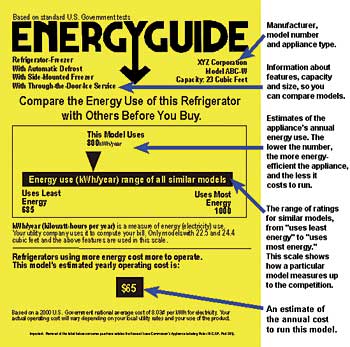Specifying Residential Appliances: Green Update
Energy Labeling Criteria. When selecting energy-efficient appliances, observe the appliance labeling. Most appliances sold in the United States are required to display a yellow ENERGY GUIDE label (similar to mileage rating labels on cars), with a line scale in the center showing how each appliance model rates in energy use compared with similar models.The estimated annual operating cost is listed below the scale, and the label gives factual, comparative information.
|
According to their literature, "ENERGY STAR® is a government-backed program helping businesses and individuals protect the environment through superior energy efficiency." ENERGY STAR® labels and logos are only awarded and displayed on appliance models that are tested and proven to consume 10 to 50 percent less energy than minimum federal efficiency standards.
 ENERGY STAR® logo and label. |
ENERGY STAR® labels apply to specific models, not just a manufacturer, so care should be taken to seek out labeled models. To learn which makes and models merit the ENERGY STAR® label, call 1-800-STAR-YES, or seewww.energystar.gov.
Water Use. Many recent standards with an emphasis on energy use also include requirements to reduce water use. In 2001, the Associated Press indicated that by 2030, the implementation of the water saving provisions of recent environmental legislation will show that water use will be cut by 10.5 trillion gallons, and $15.3 billion will be saved in electricity costs. According to the Green Guide, a GreenBiz News affiliate, "Residential water use accounts for about 10 percent of the water used in this country. This in no way diminishes the responsibility of every household to streamline use habits and invest in water-saving technology, though the consequence of doing so must be kept in perspective. In some regions, like the western U.S., where fresh water can be scarce, household consumption has a significant impact on the watershed, which affects salmon runs and the more poorly developed areas when water is diverted to supply new communities, resort areas, and agriculture." Responsible use of water is a serious and growing issue that can be addressed in plumbing fixtures, and electrical appliances that require water to operate, such as washing machines and dishwashers.
The U.S. Department of Energy states that, "Based on our estimates, a typical family with a home more than a decade old could save $200 per year in electricity and water bills, and 18,600 gallons of water, by switching to highly energy- and water-efficient appliances. If every American household installed these products, the annual water savings would equal the average flow of the Mississippi River into the Gulf of Mexico for five entire days." Water use in appliances is enough of an issue that the EPA is reportedly working on a water efficiency labeling program, similar to the ENERGY STAR® labeling program.










